Morpho–Sedimentary Monitoring in a Coastal Area, from 1D to 2.5D, Using Airborne Drone Imagery
Abstract
:1. Introduction
1.1. Interest of Morpho-Sedimentary Monitoring in the Global Change Context
1.2. Common Data Acquisition and Monitoring Methods
1.2.1. Handborne Monitoring Methods
1.2.2. Airborne (Manned Aerial Vehicle, MAV) Monitoring Method
1.2.3. Spaceborne Monitoring Method
1.3. Interest of the Use of Drone (or Unmanned Aerial Vehicle) Imagery for Coastal Monitoring
2. Materials and Methods
2.1. Study Site Presentation
General Context of the Bay of Mont-Saint-Michel
2.2. Data Acquisition
2.2.1. Ground Control Points’ Positioning
2.2.2. Imagery Acquisition Material
2.2.3. Data Acquisition Method
2.3. Data Processing
- The first step of the raw data processing consists into image calibration and image pair matching. A data set of 63 images calibrated with a median of 21,483 key points per images. Pair matching is calibrated using an exact geolocation and orientation method. It was achieved using the original image scale, and correspondence between images was conducted using the acquisition time and triangulation of the image’s geolocation.
- Previously recorded GCPs (see Section 2.2.1) are added to the result of image pair matching to correctly georeference the data set.
- Dense point cloud is generated with a high point density (number of densified points on the study area: 72 578 307).
- 2.5D textured mesh is produced at VHR from the dense point cloud. This mesh is made using a triangulated irregular network.
3. Results
3.1. 1D Monitoring
3.2. 2D Monitoring and Derived Product
3.3. 2.5D Monitoring
4. Discussion
4.1. Shoreline Analysis
4.2. Topographic Profiles’ Analysis
4.3. Point Cloud and DEM Analyses
4.4. Possible Improvements in Drone Data Acquisition
5. Conclusions
Author Contributions
Funding
Acknowledgments
Conflicts of Interest
References
- IPCC. Climate Change 2014: Synthesis Report; Contribution of Working Groups I, II and III to the Fifth Assessment Report of the Intergovernmental Panel on Climate Change Figure Core Writing Team; Pachauri, R.K., Meyer, L.A., Eds.; IPCC: Geneva, Switzerland, 2014; p. 151. [Google Scholar]
- Knutson, T.R.; McBride, J.L.; Chan, J.; Emanuel, K.; Holland, G.; Landsea, C.; Held, I.; Kossin, J.P.; Srivastava, A.K.; Sugi, M. Tropical cyclones and climate change. Nat. Geosci. 2010, 3, 157–163. [Google Scholar] [CrossRef] [Green Version]
- Etienne, S.; Jeanson, M.; Collin, A. Les services écosystémiques de protection des dépôts sédimentaires en baie du Mont-Saint-Michel; Rapport de Recherché; Conseil Général d’Ille-et-Vilaine: La Selle-en-Luitré, France, 2015; p. 75. [Google Scholar]
- Jeanson, M.; Etienne, S.; Collin, A. Wave attenuation and coastal protection by shelly ridges: Mont-Saint-Michel Bay, France. J. Coast. Res. 2016, 75, 398–402. [Google Scholar] [CrossRef]
- Mury, A.; Collin, A.; Etienne, S. Wave attenuation service of saltmarshes and shelly cheniers: A spatio-temporal study in Mont-Saint-Michel Bay, France. In Proceedings of the EGU General Assembly Conference, Vienna, Austria, 8–13 April 2018. [Google Scholar]
- Stéphan, P.; Suanez, S.; Fichaut, B.; Autret, R.; Blaise, E.; Houron, J.; Ammann, J.; Grandjean, P. Monitoring the medium-term retreat of a gravel spit barrier and management strategies, Sillon de Talbert (North Brittany, France). Ocean Coast. Manag. 2018, 158, 64–82. [Google Scholar] [CrossRef]
- Mury, A.; Jeanson, M.; Collin, A.; James, D.; Etienne, S. High Resolution Shoreline and Shelly Ridge Monitoring over Stormy Winter Events: A Case Study in the Megatidal Bay of Mont-Saint-Michel (France). J. Mar. Sci. Eng. 2019, 7, 97. [Google Scholar] [CrossRef]
- Gens, R. Remote sensing of coastlines: Detection, extraction and monitoring. Int. J. Remote Sens. 2010, 31, 1819–1836. [Google Scholar] [CrossRef]
- Ford, M. Shoreline changes interpreted from multi-temporal aerial photographs and high-resolution satellite images: Wotje Atoll, Marshall Islands. Remote Sens. Environ. 2013, 135, 130–140. [Google Scholar] [CrossRef]
- Vergouw, B.; Nagel, H.; Bondt, G.; Custers, B. Drone technology Types, payloads, applications, frequency spectrum issues and future developments. In The Future of Drone Use; Information Technology and Law Series; Custer, B., Ed.; T.M.C Asser Press: The Hague, The Netherlands, 2016; Volume 27, pp. 21–45. [Google Scholar]
- Raparelli, E.; Bajocco, S. A bibliometric analysis on the use of unmanned aerial vehicles in agricultural and forestry studies. Int. J. Remote Sens. 2019. [Google Scholar] [CrossRef]
- Gonçalves, J.A.; Henriques, R. UAV photogrammetry for topographic monitoring of coastal areas. ISPRS J. Photogramm. Remote Sens. 2015, 104, 101–111. [Google Scholar] [CrossRef]
- Mancini, F.; Dubbini, M.; Gattelli, M.; Stecchi, F.; Fabbri, S.; Gabbianelli, G. Using Unmanned Aerial Vehicles (UAV) for High-Resolution Reconstruction of Topography: The Structure from Motion Approach on Coastal Environments. Remote Sens. 2013, 5, 6880–6898. [Google Scholar] [CrossRef] [Green Version]
- Scarelli, F.M.; Cantelli, L.; Barboza, E.G.; Rosa, M.L.C.C.; Gabbianelli, G. Natural and Anthropogenic Coastal System Comparison Using DSM from a Low Cost UAV Survey (Capão Novo, RS/Brazil). J. Coast. Res. 2016, 75, 1232–1236. [Google Scholar] [CrossRef]
- Archer, A.W. World’s highest tides: Hypertidal coastal systems in North America, South America and Europe. Sediment. Geol. 2013, 284, 1–25. [Google Scholar] [CrossRef]
- Tonkin, T.N.; Midgley, N.G. Ground-Control Networks for Image Based Surface Reconstruction: An Investigation of Optimum Survey Designs Using UAV Derived Imagery and Structure-from-Motion Photogrammetry. Remote Sens. 2016, 8, 786. [Google Scholar] [CrossRef]
- Lejot, J.; Delacourt, C.; Piegay, H.; Fournier, T.; Tremelo, M.L.; Allemand, P. Very high spatial resolution imagery for channel bathymetry and topography from an unmanned mapping controlled platform. Earth Surf. Process. Landf. 2007, 32, 1705–1725. [Google Scholar] [CrossRef]
- Diffusion SHOM. Lidar NHDF 2016–2017 Produit Partiel “Partie Maritime”. Available online: https://diffusion.shom.fr/media/wysiwyg/pdf/Readme-Produit-maritime-partiel-LidarNHDF-V20180501total.pdf (accessed on 26 July 2019).
- Boak, E.H.; Turner, I.L. Shoreline Definition and Detection: A Review. J. Coast. Res. 2005, 214, 688–703. [Google Scholar] [CrossRef]
- Lucieer, A.; Turner, D.; King, D.H.; Robinson, S.A. Using and unmanned aerial vehicle (UAV) to capture micro-topography of Antartic moss beds. Int. J. Appl. Earth Obs. Geoinf. 2014, 27, 53–62. [Google Scholar] [CrossRef]
- Bonnot-Courtois, C.; Fournier, J.; Dréau, A. Recent morphodynamics of shell banks in the western part of the Bay of Mont-Saint-Michel (France). Géomorphol. Relief Process. Environ. 2004, 10, 65–79. [Google Scholar] [CrossRef]
- Yanagi, H.; Chikatsu, H. Performance evaluation of 3D modelling software for UAV photogrammetry. Int. Arch. Photogramm. Remote Sens. Spat. Inf. Sci. 2016, XLI-B5, 147–152. [Google Scholar] [CrossRef]
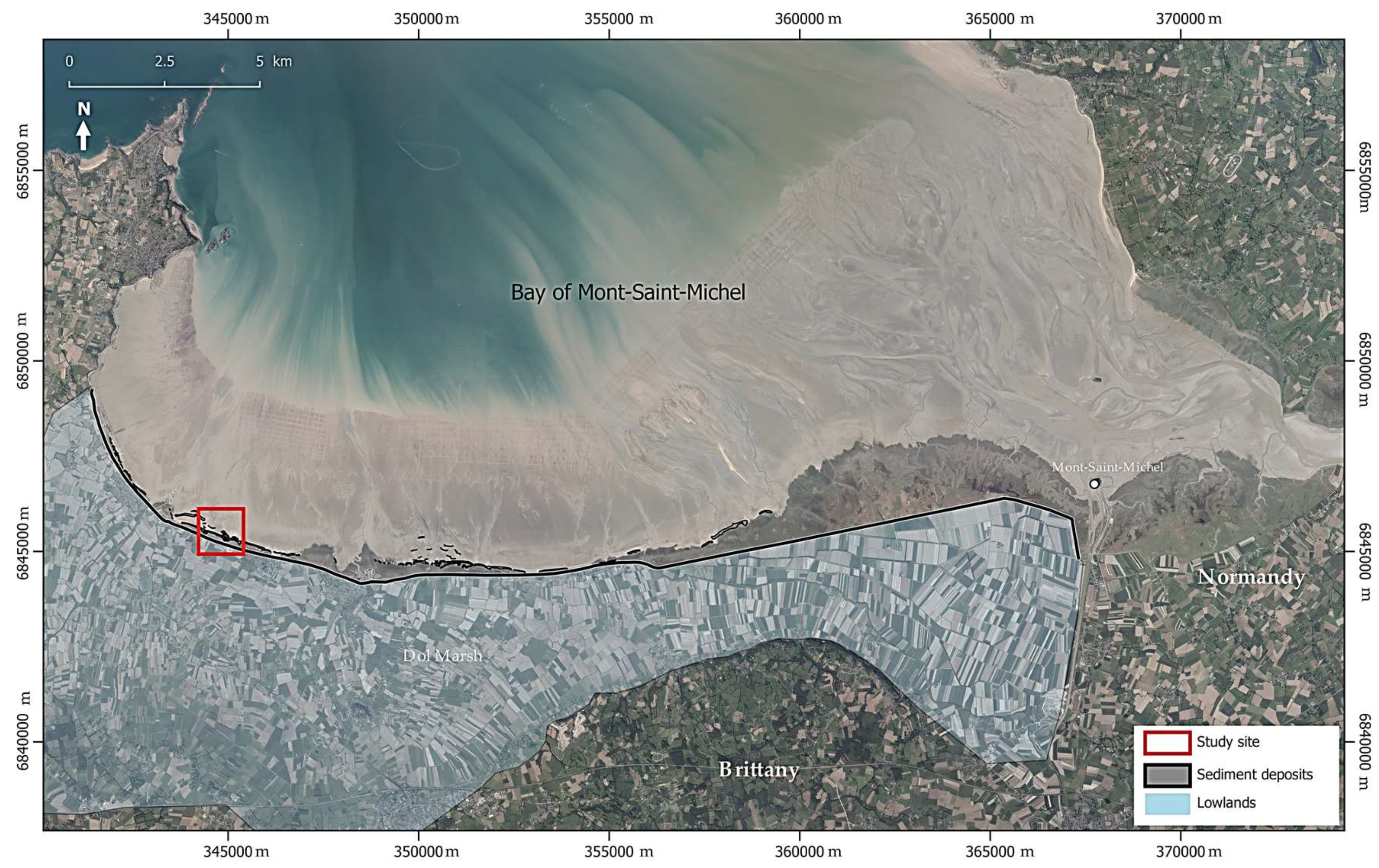
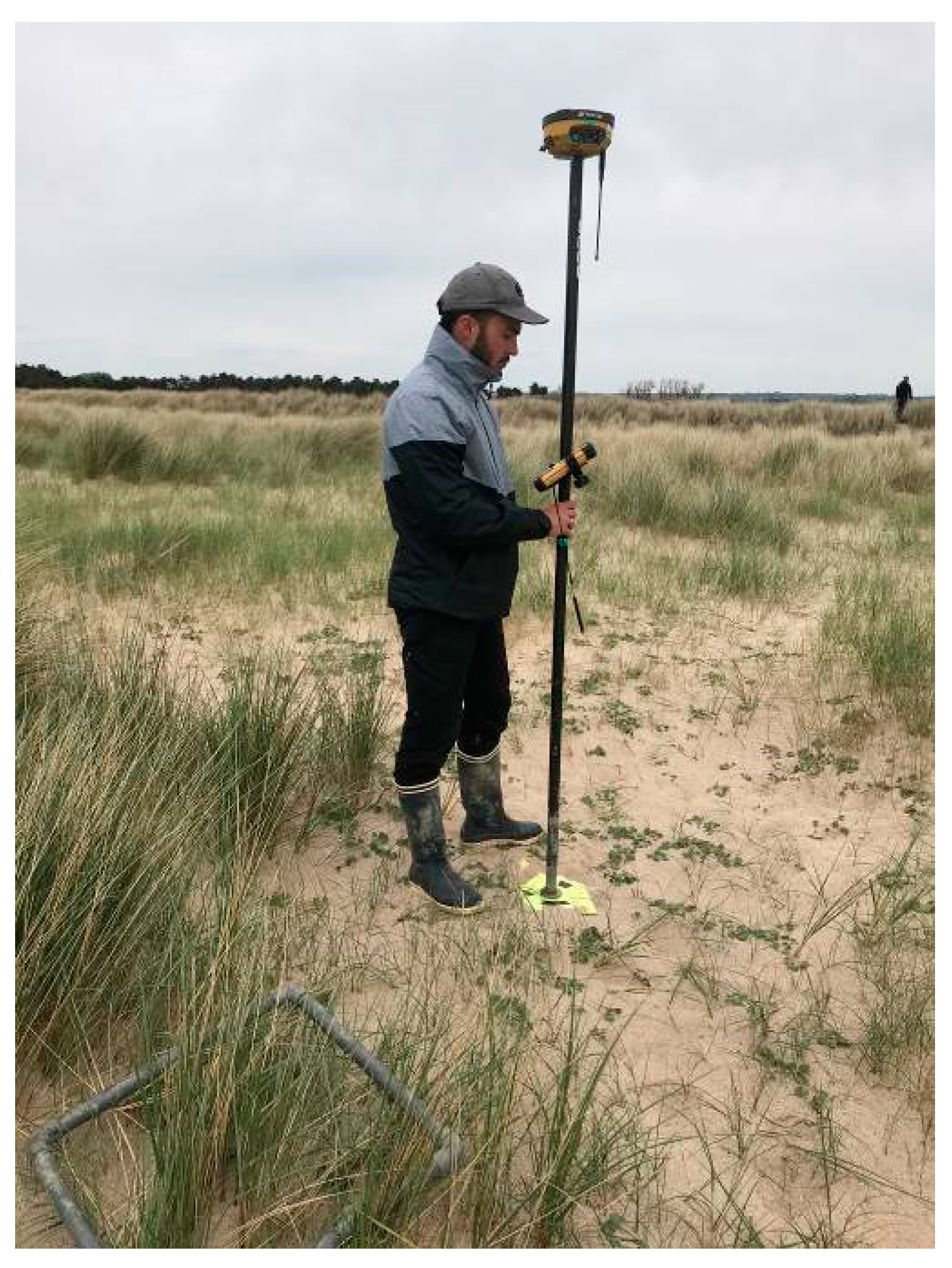
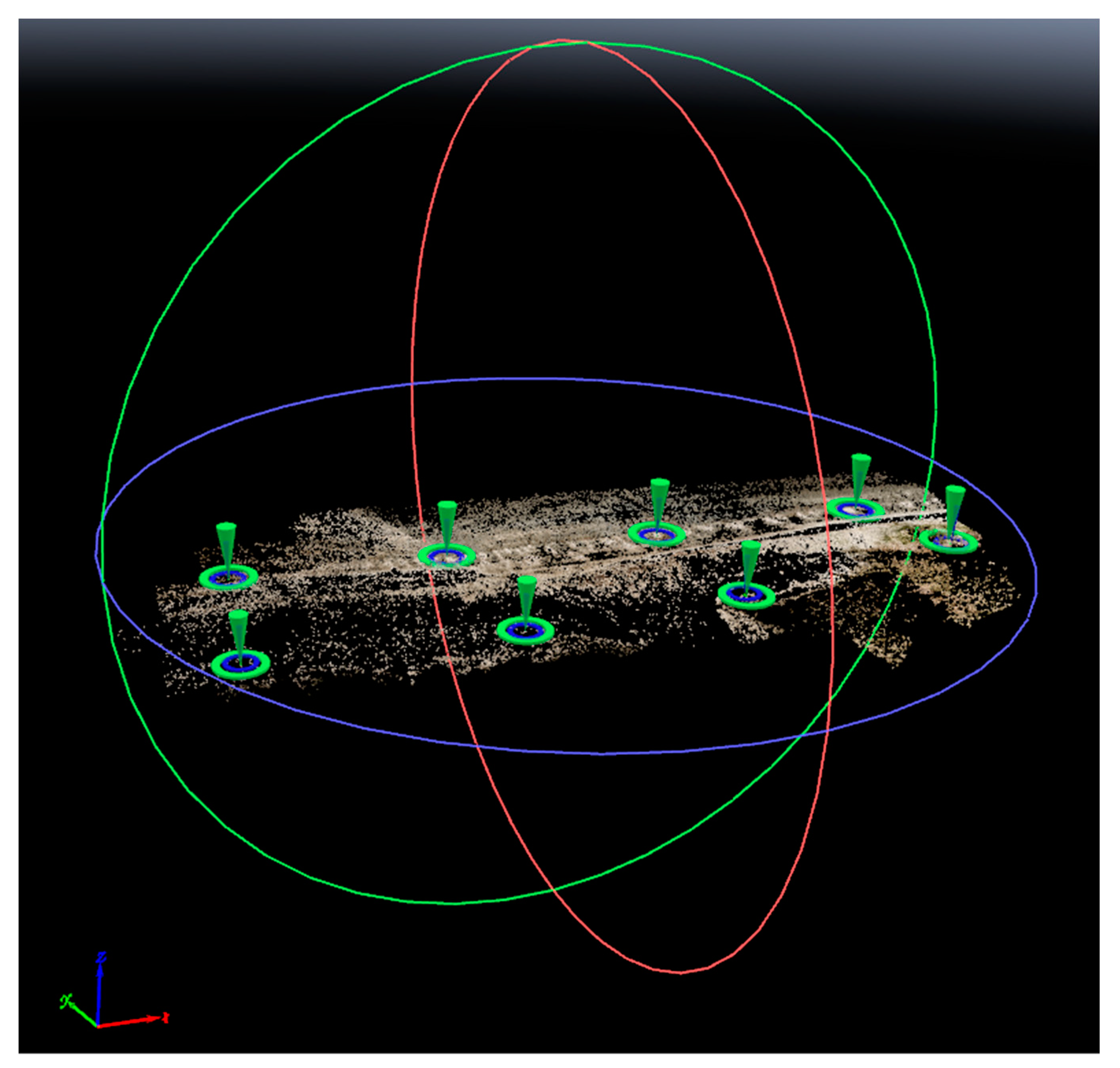
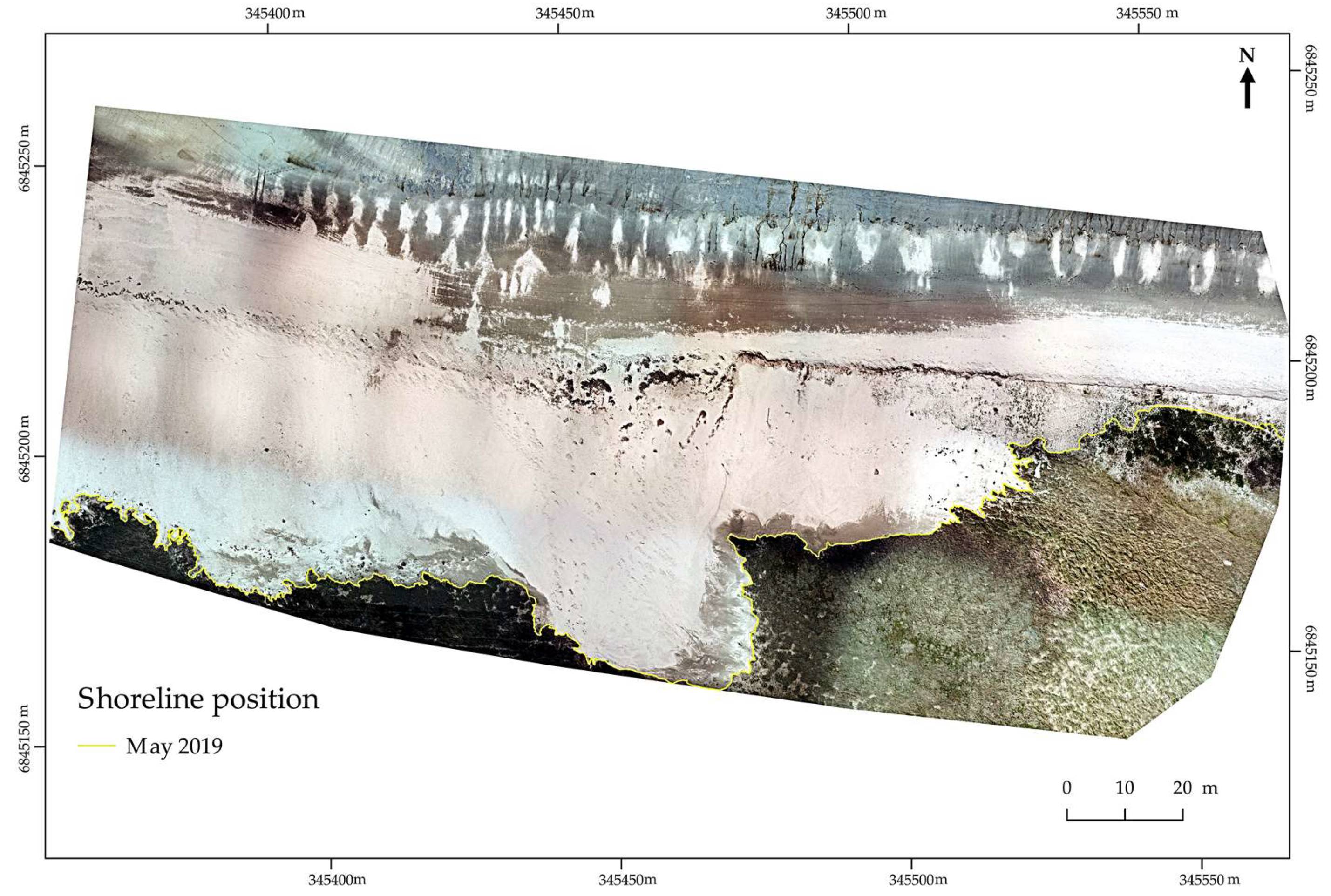
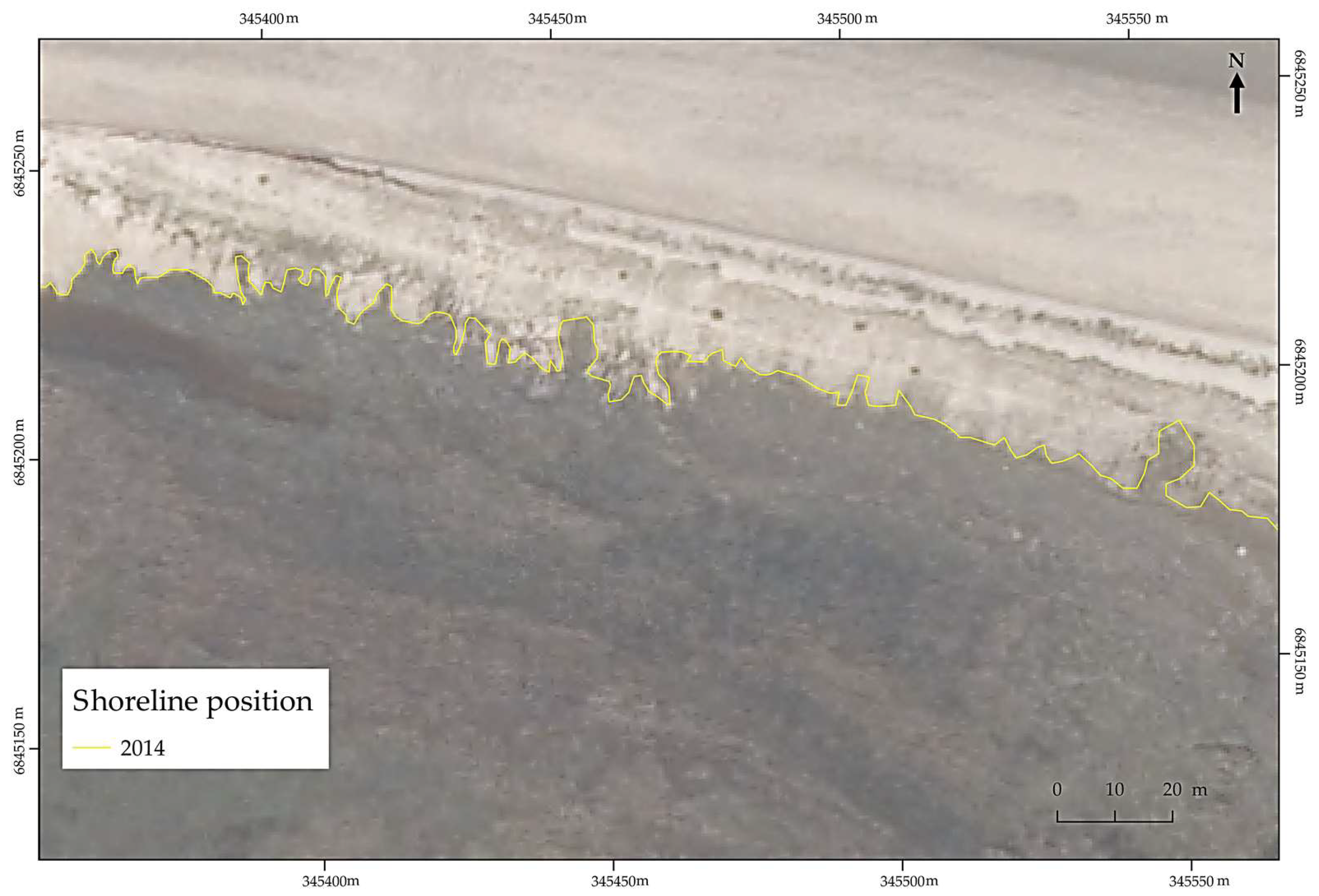
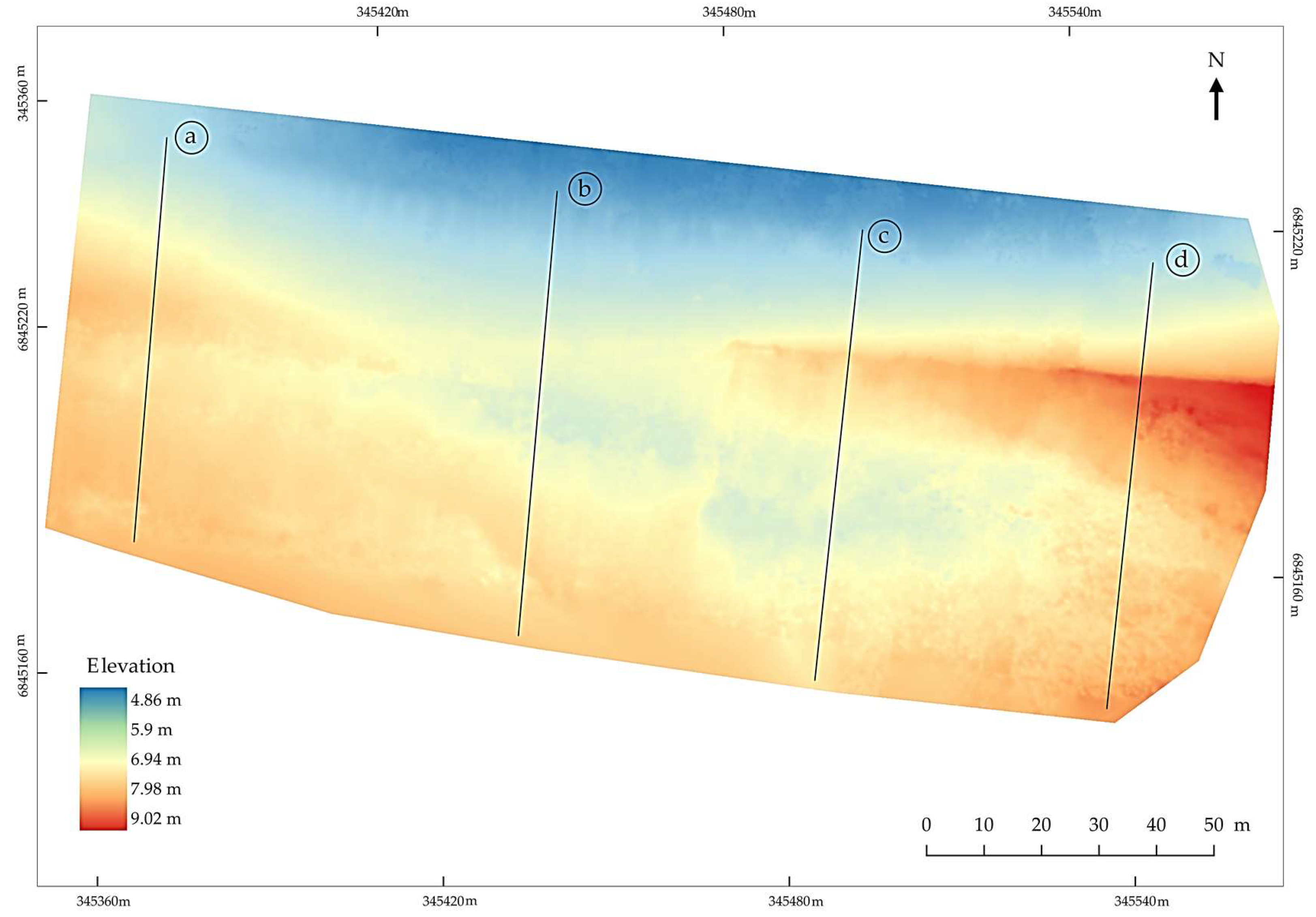
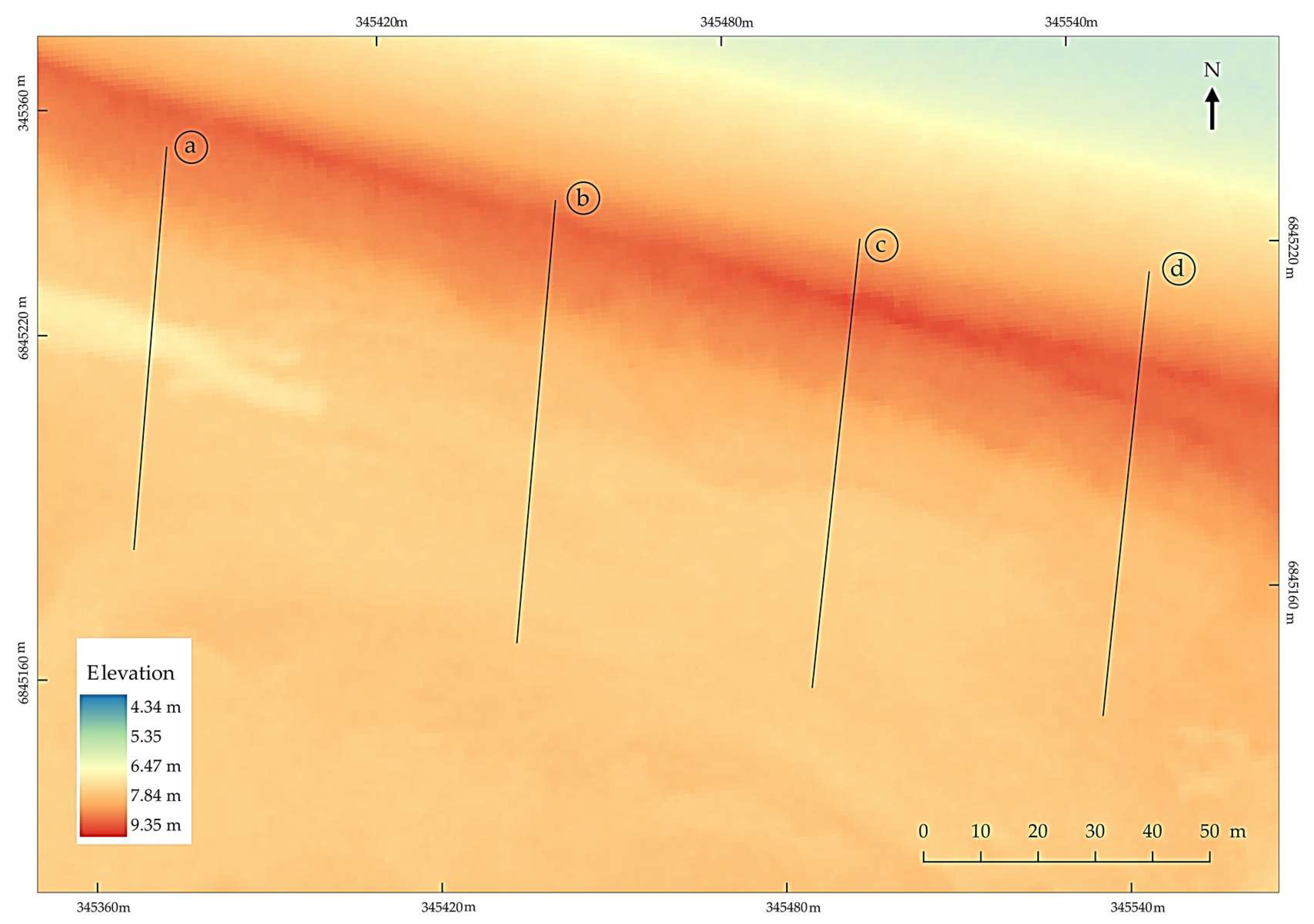
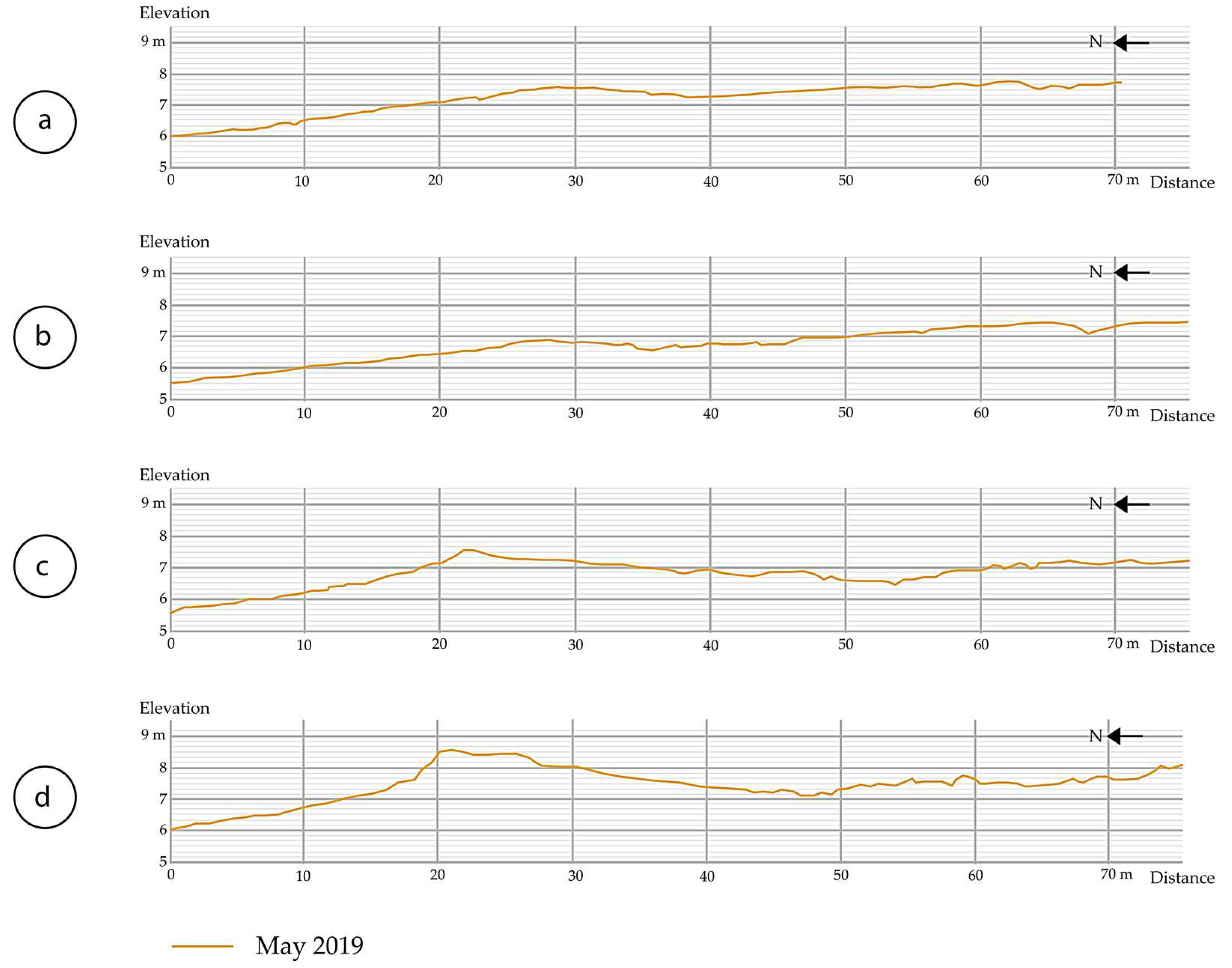

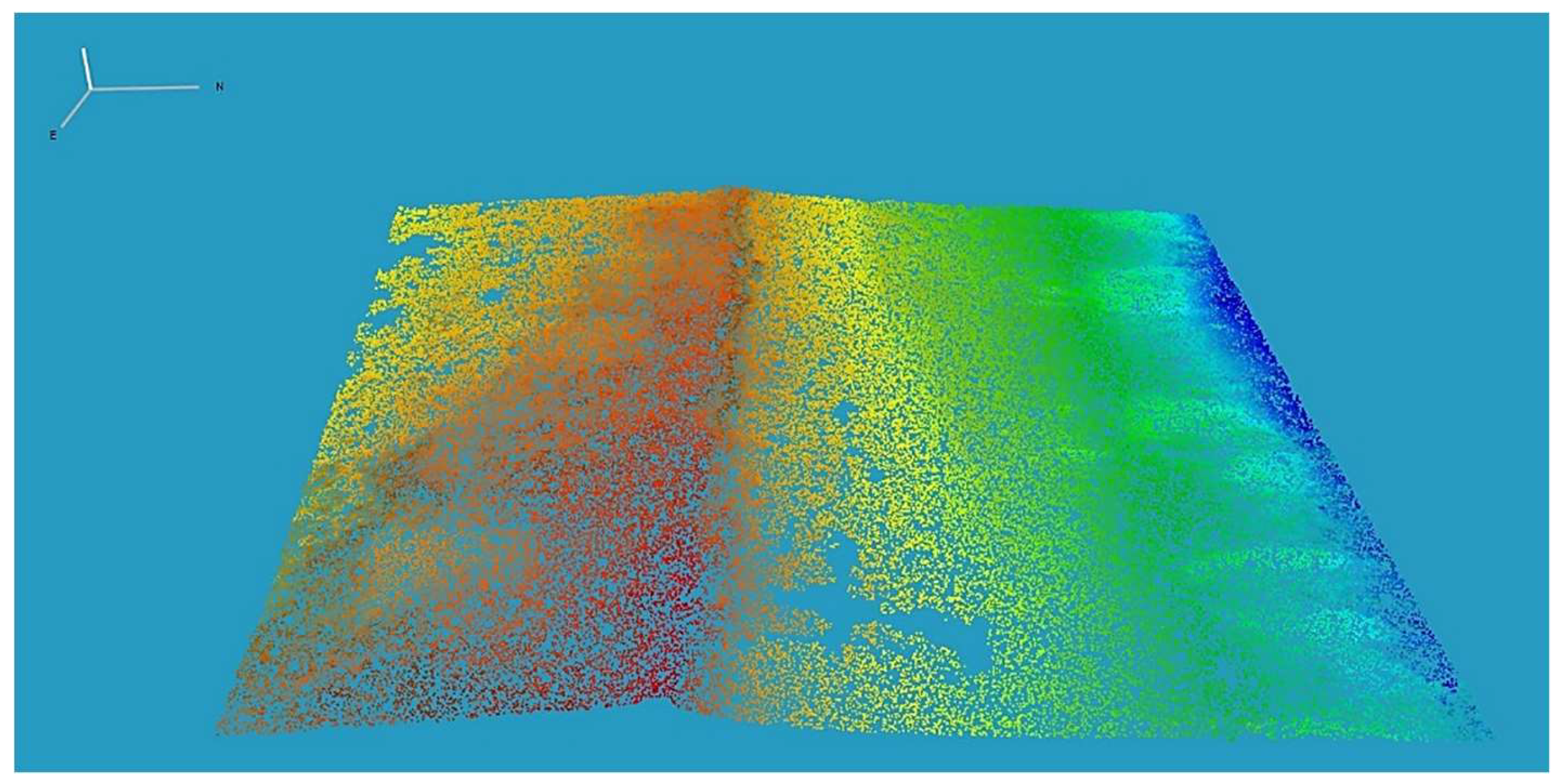

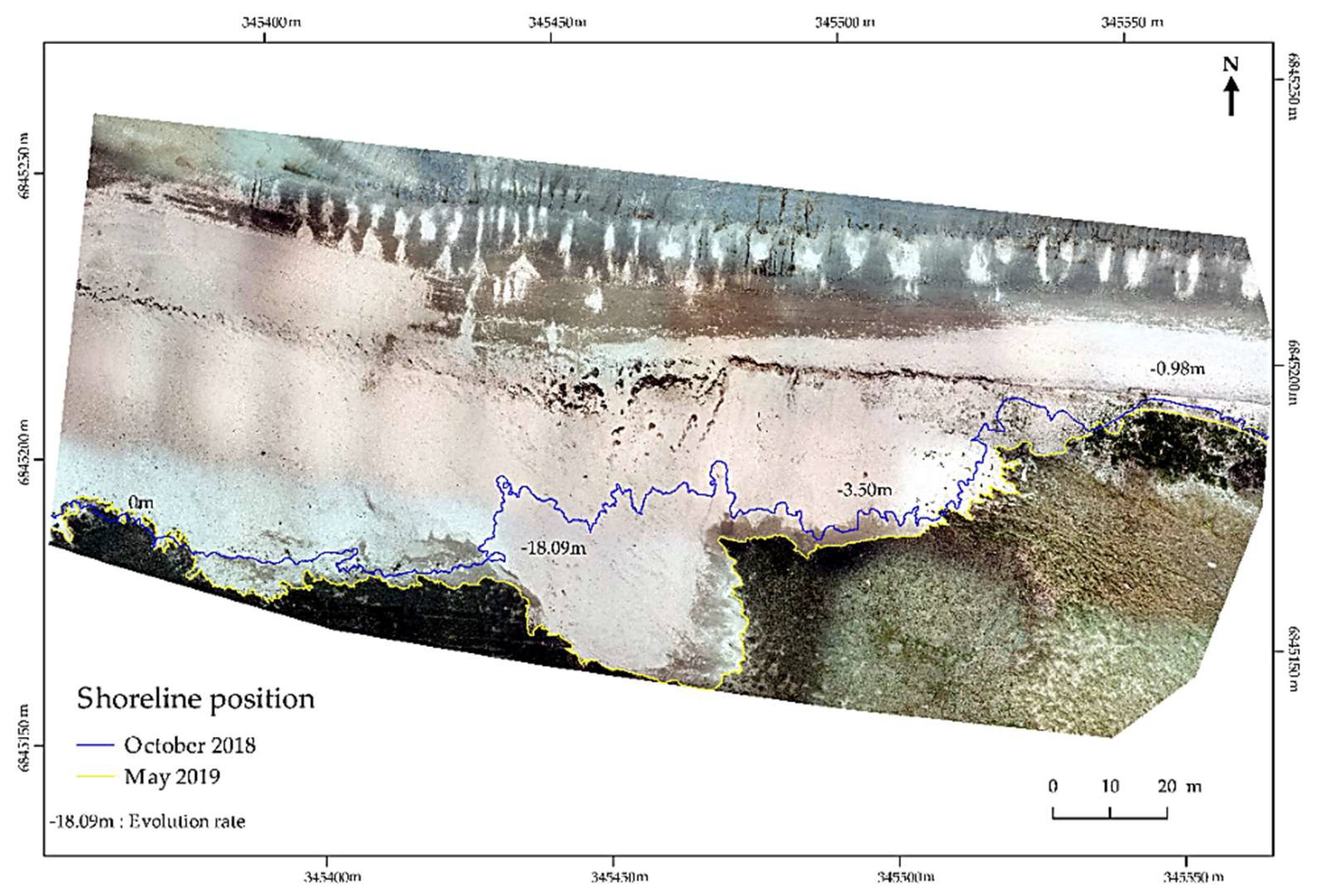
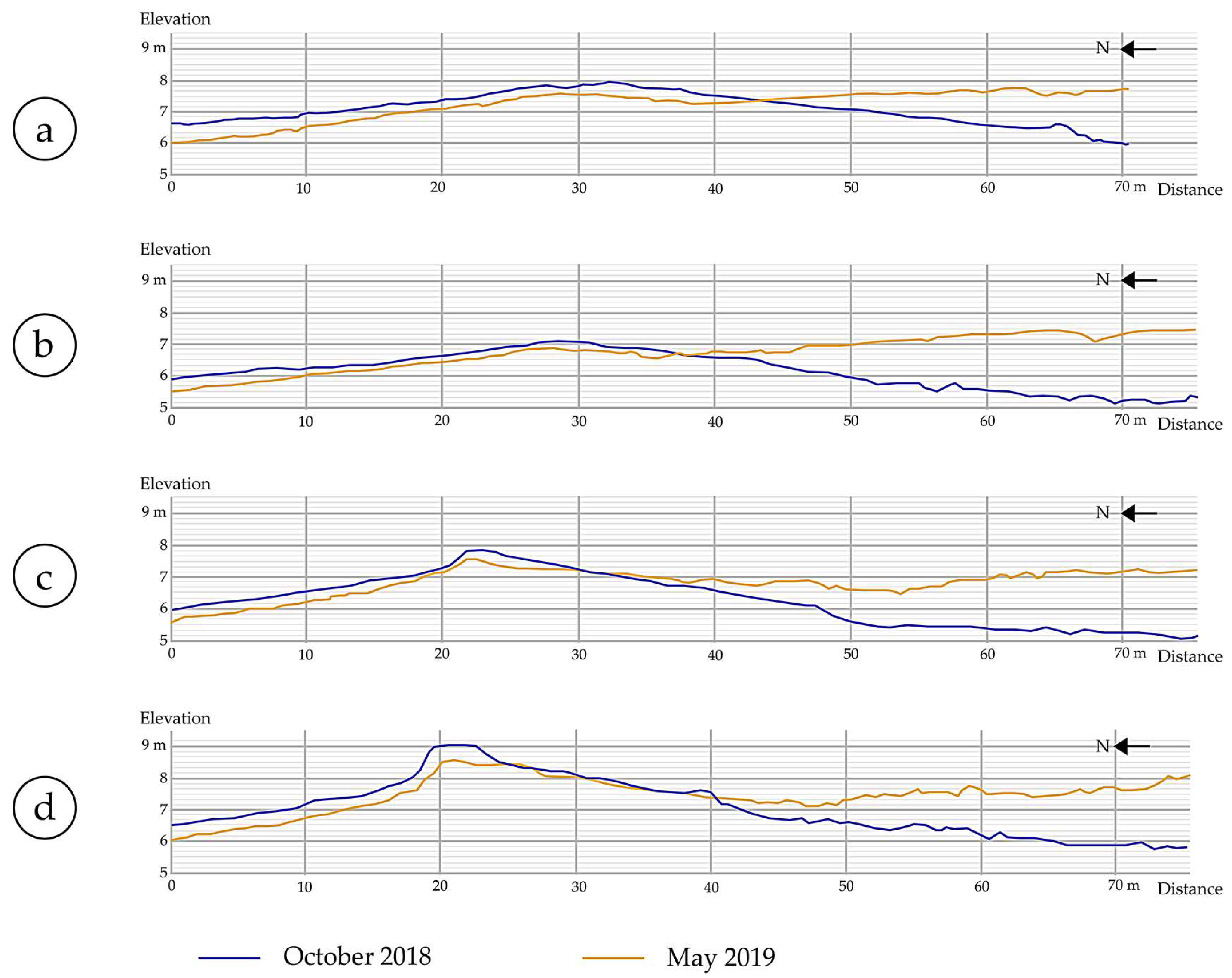
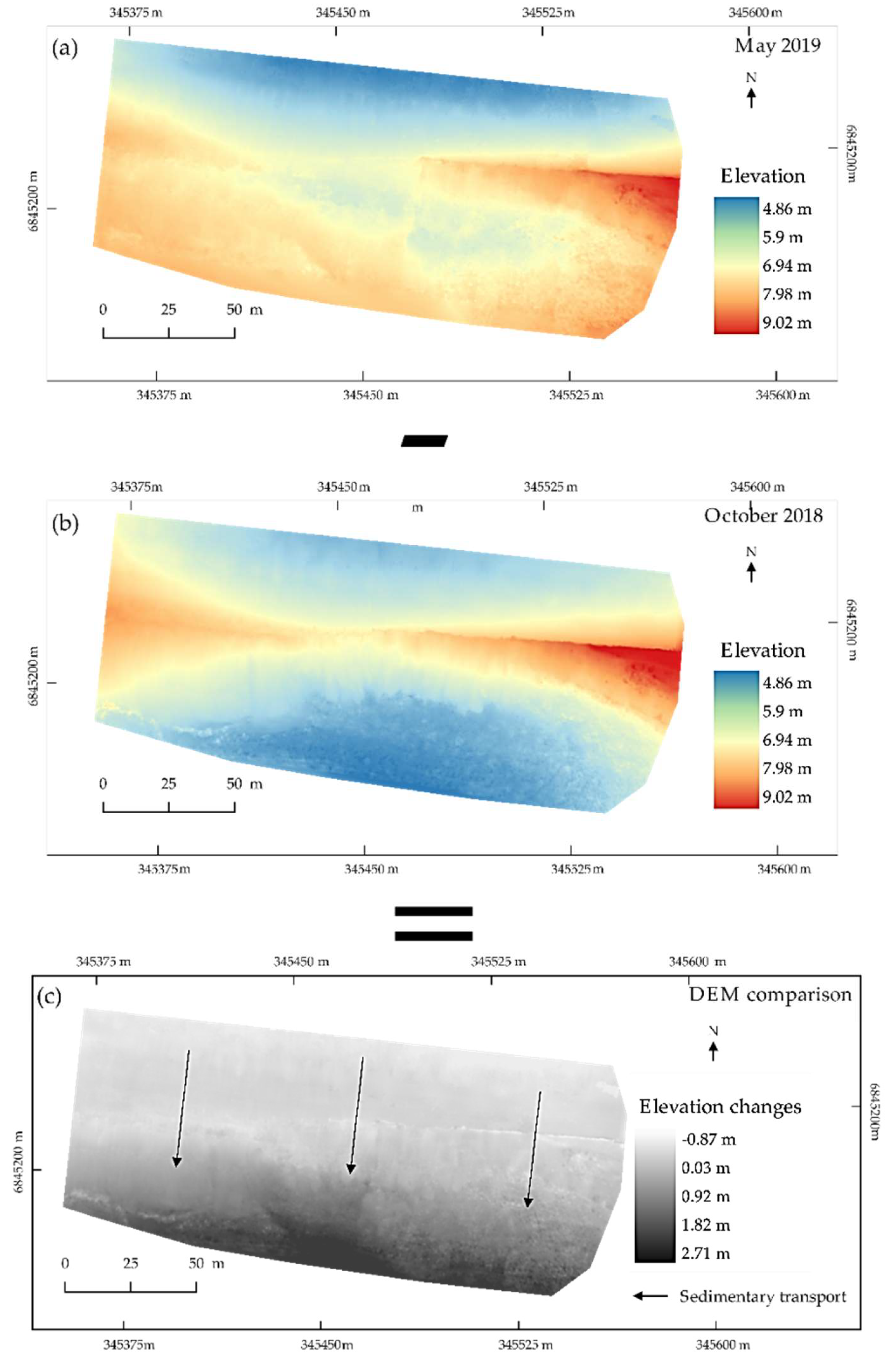

| Data Source | Spatial Resolution/Point Distance (m) | Accuracy (m) | |
|---|---|---|---|
| Horizontal | Vertical | ||
| Handborne | |||
| DGNSS | N/A | <0.1 | <0.1 |
| Tachometer | N/A | <0.1 (under 300 m distance) | <0.1 (under 300 m distance) |
| Airborne (manned aerial vehicle) | |||
| Optical imagery | >0.2 | N/A | N/A |
| LiDAR | >0.2 | <0.1 | 0.15–0.2 |
| Spaceborne | |||
| Landsat 8 | 15 (panchromatic)/30 (multispectral) | 12 (CE90) | N/A |
| SPOT 6–7 | 1.5 (panchromatic)/6 (multispectral) | 10 (CE90) | N/A |
| WorldView-2 | 0.46 (panchromatic)/1.84 (multispectral) | 3.5 (CE90) | N/A |
| WorldView-3 | 0.31 (panchromatic)/1.24 (multispectral) | 3.5 (CE90) | N/A |
| Pleiades-1 | 0.5 (panchromatic)/2 (multispectral) | 3 (CE90) | N/A |
| GeoEye-1 | 0.41 (panchromatic)/1.65 (multispectral) | 5 (CE90) | N/A |
| UAV model | DJI Mavic Pro Platinum |
| Sensor | 1/2.3” (CMOS) |
| No. of pixel | Total pixels: 12.71 MP Effective pixels: 12.35 MP |
| Lens | FOV 78.8°, Focus: 28 mm (35 mm format equivalent) Aperture: f/2.2 |
| Flight planning and control software | DJI GS Pro |
| Name | Ortho-littorale v2 | LiDAR 2018 |
| Type of data | MAV orthomosaic | MAV point cloud |
| Production date | 2014 | 2018 |
| Data producer(s) | MEDDE-CEREMA | SHOM |
| Spatial resolution | 0.5 m × 0.5 m | <0.20 m |
| Horizontal accuracy | <1.2 m | 2.0 m |
| Vertical accuracy | - | <0.40 m |
| Flight planning software | DJI GS Pro |
| Front overlap ratio | 60% |
| Side overlap ratio | 60% |
| Height | 50 m |
| Gimbal pitch angle | −90° |
| Shutter interval | 2.0 s |
| Flying time | 12 mn |
| Data Source | Point Density | |||
|---|---|---|---|---|
| Min. | Max. | Mean | Std dev. | |
| UAV Drone | 786.06 | 3504.77 | 2571.86 | 805.26 |
| MAV LiDAR | 11.52 | 53.69 | 29.98 | 14.02 |
© 2019 by the authors. Licensee MDPI, Basel, Switzerland. This article is an open access article distributed under the terms and conditions of the Creative Commons Attribution (CC BY) license (http://creativecommons.org/licenses/by/4.0/).
Share and Cite
Mury, A.; Collin, A.; James, D. Morpho–Sedimentary Monitoring in a Coastal Area, from 1D to 2.5D, Using Airborne Drone Imagery. Drones 2019, 3, 62. https://doi.org/10.3390/drones3030062
Mury A, Collin A, James D. Morpho–Sedimentary Monitoring in a Coastal Area, from 1D to 2.5D, Using Airborne Drone Imagery. Drones. 2019; 3(3):62. https://doi.org/10.3390/drones3030062
Chicago/Turabian StyleMury, Antoine, Antoine Collin, and Dorothée James. 2019. "Morpho–Sedimentary Monitoring in a Coastal Area, from 1D to 2.5D, Using Airborne Drone Imagery" Drones 3, no. 3: 62. https://doi.org/10.3390/drones3030062
APA StyleMury, A., Collin, A., & James, D. (2019). Morpho–Sedimentary Monitoring in a Coastal Area, from 1D to 2.5D, Using Airborne Drone Imagery. Drones, 3(3), 62. https://doi.org/10.3390/drones3030062





